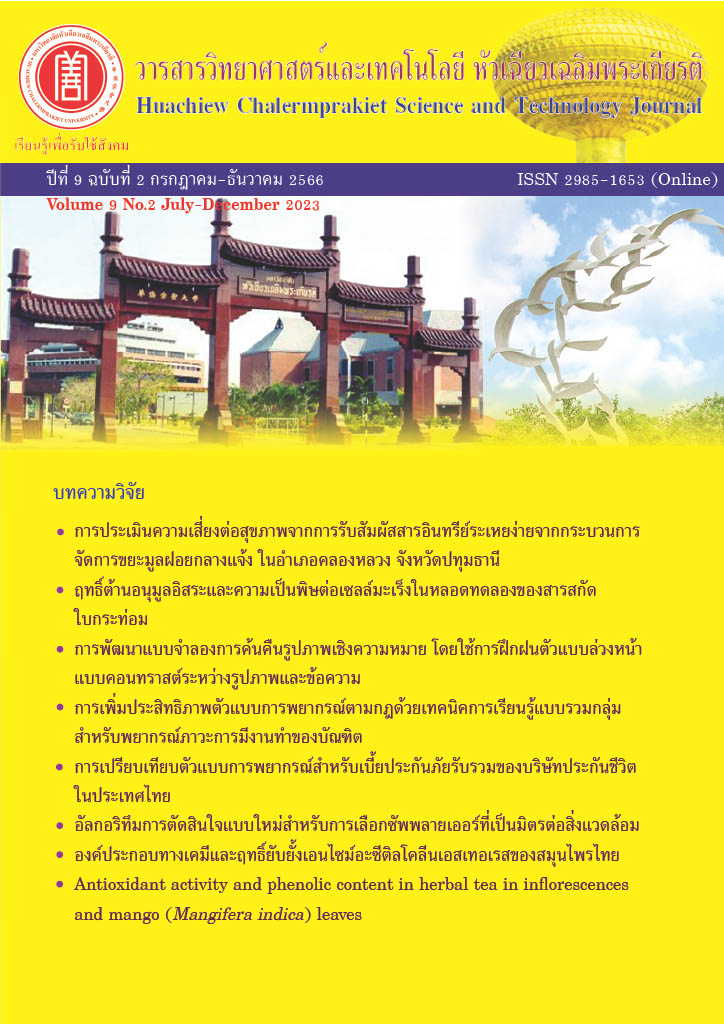องค์ประกอบทางเคมีและฤทธิ์ยับยั้งเอนไซม์อะซีติลโคลีนเอสเทอเรสของสมุนไพรไทย
คำสำคัญ:
สมุนไพรไทย, มะม่วงหิมพานต์, ฤทธิ์ยับยั้งเอนไซม์อะซีติลโคลีนเอสเทอเรส, ลิควิดโครมาโทกราฟี-แมสสเปกโทรเมทรี/แมสสเปกโทรเมทรีบทคัดย่อ
โรคอัลไซเมอร์ จัดเป็นโรคความเสื่อมของระบบประสาท ในปัจจุบันแนวทางการรักษาของโรคอัลไซเมอร์คือ การเพิ่มปริมาณสารสื่อประสาทอะซีติลโคลีนในสมองโดยใช้ยาที่มีคุณสมบัติในการยับยั้งเอนไซม์อะซีติลโคลีนเอสเทอเรส งานวิจัยนี้มีวัตถุประสงค์เพื่อศึกษาฤทธิ์ยับยั้งเอนไซม์อะซีติลโคลีนเอสเทอเรสจากสมุนไพรไทยทั้งหมด 7 ชนิด ได้แก่ ใบเหลียง ใบมะม่วง หิมพานต์ ใบบัวบก ใบมะรุม ใบมะกอก ใบมันปู และใบหมุย ที่ถูกสกัดด้วยตัวทำละลายเอทานอลและวิเคราะห์องค์ประกอบเคมีของสารสกัดที่ออกฤทธิ์ด้วยเทคนิคลิควิดโครมาโทกราฟี-แมสสเปกโทรเมทรี/แมสสเปกโทรเมทรี เนื่องจากมีรายงานการวิจัยเกี่ยวกับฤทธิ์นี้ค่อนข้างน้อย พบว่าสารสกัดใบมะม่วงหิมพานต์แสดงฤทธิ์ในการยับยั้งเอนไซม์อะซีติลโคลีนเอสเทอเรสสูงที่สุดด้วย ค่า IC50 เท่ากับ 181 ไมโครกรัมต่อมิลลิลิตร ผลการวิเคราะห์แมสสเปกตรัมของสารสกัดใบมะม่วงหิมพานต์เปรียบเทียบกับสารสกัดใบมันปูและสารสกัดใบเหลียงที่แสดงฤทธิ์ในการยับยั้งปานกลางและน้อย พบสารประกอบฟลาโวนอยด์ (isorhamnetin-3-O-glucoside, 3'-O-methyl-(-)-epicatechin-7-O-sulphate และ apigenin 7-sulfate), สารประกอบฟีนอลิก (4-O-methylgallic acid) และสารประกอบ phosphatidylcholine ที่คาดว่าเป็นองค์ประกอบหลักของสารสกัดใบมะม่วงหิมมานต์ในการออกฤทธิ์ยับยั้งเอนไซม์อะซีติลโคลีนเอสเทอเรส จากผลวิจัยนี้ชี้ให้เห็นว่าสารสกัดใบมะม่วงหิมพานต์สามารถนำมาพัฒนาเป็นอาหารเสริมทางการแพทย์ป้องกันโรคอัลไซเมอร์ต่อไปได้
เอกสารอ้างอิง
Thummayot S, Tocharus C, Pinkaew D, Viwatpinyo K, Sringarm K, Tocharus J. Neuroprotective effect of purple rice extract and its constituent against amyloid beta-induced neuronal cell death in SK-N-SH cells. NeuroToxicology 2014;45:149-58.
Savaspun K, Surangkul D, Phanumartwiwath A, Sam-ang P. Antioxidant and acetylcholinesterase inhibitory activities of crude and fractionated extracts from tong taek (Baliospermum Solanifolium) leaves. PSRU J Sci Tech 2020;5(1):107-22.
Marucci G, Buccioni M, Ben DD, Lambertucci C, Volpini R, Amenta F. Efficacy of acetylcholinesterase inhibitors in Alzheimer's disease. Neuropharmacology 2021;190:108352-66.
Roseiro LB, Rauter AP, Serralheiro MLM. Polyphenols as acetylcholinesterase inhibitors: Structural specificity and impact on human disease. Nutr Aging 2012;1:99-111.
Das J, Mannan A, Rahman M, Dinar MAM, Uddin ME, Khan I, et al. Chloroform and ethanol extract of Spondias Pinnata and its different pharmacological activity like-antioxidant, cytotoxic, antibacterial potential and phytochemical screening through in vitro method. Int J Res Pharm Biomed Sci 2011;2(4):1805-12.
Jain P, Rufaka Hossain K, Rashid Mishu T, Mahmud Reza H. Antioxidant and antibacterial activities of Spondias pinnata Kurz. leaves. European J Med Plants 2013;4(2):183-95.
Adisakwattana S, Chanathong B. Alpha-glucosidase inhibitory activity and lipid-lowering mechanisms of Moringa oleifera leaf extract. Eur Rev Med Pharmacol Sci 2011;15(7):803-8.
Jabamalai raj A, Gopalakrishnan VK, Alagar Yadav DS, Dorairaj S. Antimicrobial activity of Moringa oleifera (Lam.) root extract. J Pharm Res 2011;4(5):1426-7.
Oluduro AO. Evaluation of Antimicrobial properties and nutritional potentials of Moringa oleifera Lam. leaf in South-Western Nigeria. Malays J Microbiol 2012;8:59-67.
Ukwenya V, Ashaolu J, Adeyemi D, Akinola O, Caxton-Martins E. Antihyperglycemic activities of methanolic leaf extract of Anacardium occidentale (Linn.) on the pancreas of streptozotocin-induced diabetic rats. J Cell Anim Biol 2012;6:207-12.
Panpipat W, Suttirak W, Chaijan M. Free radical scavenging activity and reducing capacity of five Southern Thai indigenous vegetable extracts. Walailak J Sci & Tech 2011;7(1):51-60.
Zohora F, Hasan C, Ahsan M. Chemical constituents, cytotoxic activities and traditional uses of Micromelum minutum (Rutaceae): a review. Pharm Pharmacol Int J 2019;7(5):229-36.
Yakoh K, Weschasat T, Suwannachote P. Phenolic compound of 10 indigenous vegetables from Surat Thani province. J Thai Trad Alt Med 2018;16(2):185–94.
Siddiqui BS, Aslam H, Ali ST, Khan S, Begum S. Chemical constituents of Centella asiatica. J Asian Nat Prod Res 2007;9(4):407-14.
Sam-ang P, Surangkul D, Savaspun K, Phanumartwiwath A. Antioxidant and acetylcholinesterase inhibitory activities of Morinda citrifolia L. extracts. Agr Nat Resour 2020;54(2):173-9.
Boonchaisri S, Rochfort S, Stevenson T, Dias DA. LC-MS untargeted metabolomics assesses the delayed response of glufosinate treatment of transgenic glufosinate resistant (GR) buffalo grasses (Stenotaphrum secundatum L.). Metabolomics 2021;17(3):28-44.
Ragasa C, Medecilo M, Shen c-c. Chemical Constituents of Moringa oleifera Lam. Leaves. Der Pharma Chemica 2015;7(7):395-9.
Anantachoke N, Kitphati W, Mangmool S, Bunyapraphatsara N. Polyphenolic compounds and antioxidant activities of the leaves of Glochidion hypoleucum. Nat Prod Commun 2015;10(3):479-82.
Ito C, Otsuka T, Ruangrungsi N, Furukawa H. Chemical constituents of Micromelum minutum Isolation and structural elucidation of new coumarins. Chem Pharm Bull 2000;48(3):334-8.
Shah A, Smith DL. Flavonoids in agriculture: chemistry and roles in, biotic and abiotic stress responses, and microbial associations. Agronomy 2020;10(8):1209-34.
Olennikov DN, Kashchenko NI, Chirikova NK, Akobirshoeva A, Zilfikarov IN, Vennos C. Isorhamnetin and quercetin derivatives as anti-acetylcholinesterase principles of marigold (Calendula officinalis) flowers and preparation. Int J Mol Sci 2017;18(8):1685-701.
Le TH, Van Do TN, Nguyen HX, Dang PH, Nguyen NT, Nguyen MTT. A new phenylheptanoid from the leaves of Gnetum gnemon L. Nat Prod Res 2021;35(21):3999-4004.
ดาวน์โหลด
เผยแพร่แล้ว
รูปแบบการอ้างอิง
ฉบับ
ประเภทบทความ
สัญญาอนุญาต
ลิขสิทธิ์ (c) 2023 วารสารวิทยาศาสตร์และเทคโนโลยี หัวเฉียวเฉลิมพระเกียรติ

อนุญาตภายใต้เงื่อนไข Creative Commons Attribution-NonCommercial-NoDerivatives 4.0 International License.
บทความทุกบทความที่ได้รับการตีพิมพ์ถือเป็นลิขสิทธิ์ของ คณะวิทยาศาสตร์และเทคโนโลยี มหาวิทยาลัยหัวเฉียวเฉลิมพระเกียรติ



